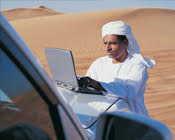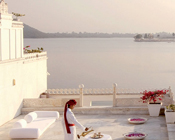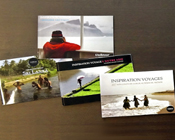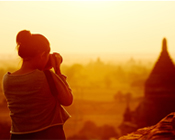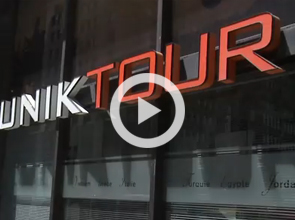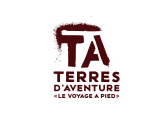Overview
Country Information
- Climb Kilimanjaro with your own private guide!
- Mount Kilimanjaro: Africa’s most famous landmark. Its eternal snows have seduced countless trekkers for generations, with good reason: if you are physically fit, you can climb to the roof of Africa, culminating at 5895 meters.
Though trekkers do have to put in a little extra effort on the Machame route compared to other routes, they are rewarded with magnificent scenery throughout their trek, transforming their journey into an unforgettable experience! This the most demanding route up the Kilimanjaro in terms of terrain, but also in terms of sleeping arrangements: the lack of campsites means accommodation is in the form of bivouacs – set up by your private guide and his team!
Though the Machame route stretches for 40 km (compared to 20 km for the Marangu route), it has the advantage of drawing a loop, which means the ascent and descent follow different paths. The ascent takes an extra day, which means better acclimatization, so that success rates remain high even for this route. As if that weren’t enough, this itinerary includes a full day of acclimatization to help you make it to the top. Don’t worry: the amazing thrills and breathtaking scenery accompanying you every step of the way will reward any extra effort you might have put into climbing to the top of Kilimanjaro!
And let’s not forget that this journey will also allow travelers to discover African wildlife in Arusha Park, with Kilimanjaro in the background…
Contact our Kilimanjaro expert today for more information on this unique private guided expedition!
- Day 1 | International flight
- Day 2 | Airport reception and transfer to Moshi (alt: 800m)
Meet and greet at Kilimanjaro airport and transfer to Kia Lodge (3-star) for the night.
- Day 3 | Safari in Arusha National Park
(Alternatively, this can also be a day of leisure)
After breakfast, enjoy a safari in this small park (137 km2) where many different habitats thrive: a high-altitude forest and cascades at Mount Meru, the Ngurdoto, a volcano whose crater is home to many mammals, and the 7 Momela Lakes where beautiful water birds live. On a sunny day, we are blessed with breathtaking views of Mount Meru and Kilimanjaro. Many animals live in this park: giraffes, elephants, buffalo, hippopotamuses, rhinoceros, colobus monkeys, antelopes, and warthogs. In the afternoon, transfer to Moshi, a small town nestled at the foot of the Kilimanjaro. Settle into your 3-star hotel. Meet the team leader for a briefing and prepare your ascent. Dinner and overnight at hotel.
- Day 4 | Machame Gate (1 900m) - Machame Camp (3 050m)
5-7 h walk, 1150 m ascent
Transfer from your hotel to the entrance to Kilimanjaro Park for registration and the start of your trek. You will cross an equatorial forest until you reach Machame Hut (2900m), enjoying a picnic on the way. Magnificent views of Kibo. Dinner and camping close to Machame Camp.
- Day 5| Machame Camp (3 050m) - Shira Camp (3 658m)
5-7 h walk, 850m ascent
Early morning departure, first climbing through a forest and then through less dense, steppe-like vegetation. After rugged terrain in the morning, enjoy a short but restful picnic, followed by a walk above the clouds until Shira plateau, where the views are splendid. Set up bivouac at the foot of Kibo. Dinner at campsite.
- Day 6 | Shira Camp (3 658m) - Barranco Camp (3 860m)
6-7 h walk, 680m ascent
Climb above Shira and descend 700m in the morning, followed by a progressive climb heading east, passing by the foot of the Lava Tower (4630m) after around 5 hours of hiking. After lunch, 700m descent to Barranco Camp (very beneficial for acclimatization) with great views on the Barranco Wall and the Western Breach. With a little bit of luck, you will be blessed with an incredible sunset while your dinner is prepared. Overnight in a tent.
- Day 7| Acclimatization day at Barranco Camp (3 860m)
A complete day of resting and walking around Barranco, full board, for better acclimatization – and better chances of making it to the top. Dinner and overnight at Barranco Camp.
- Day 8 | Barranco Camp (3 950m) - Barafu Camp (4 550m)
8h walk, 380m descent and 650m ascent
After spending a (spectacular) night at Barranco Wall, you’ll cross Karanga Valley and Mweka route before arriving at Barafu Hut (alt: 4600m), after around 8 hours of hiking. “Barafu” is the Swahili word for ice. Dinner and rest at camp.
- Day 9 | Final ascent – Kilimanjaro Summit
6 to 10 hours of strenuous walking, climbing 1295m
Your final ascent towards the highest point in Africa starts around midnight. The path is very steep. Arrive at Stella Point (5745m) after around 8 hours of hiking. At Uhuru Peak (5895m), your efforts will be rewarded by a glorious sunrise! Descent to Barafu Hut (approx 3 hours) for a well-earned rest, then descent to Mweka Hut where we spend the night, bivouac-style.
- Day 10 | Descent to Mweka
4 - 8 hours walk, 2195m descent from Uhuru to Horombo, for a total descent of 2795m once you reach Mweka
After a complete breakfast, walk through the forest to arrive at the Park’s entrance. Sign the golden book at Mweka Gate where successful climbers are awarded a certificate. A well-earned warm meal will be served. Take the road to Moshi where a warm shower will feel like heaven! Evening and overnight at Key’s hotel, a friendly place where many climbers meet. (2-star B&B)
- Day 11| Departure or Trip extension
Transfer to the airport and international flight or trip extension for a safari with private guide or to Zanzibar.
| Fares (on-site) | |
|---|---|
| Price per person | 5700$CAD |
** Budgets displayed on this website are provided for information purpose only and do not have any contractual value, Uniktour cannot be held responsible for any consequences related to this information (departure dates are not indicated). Fares are led to change on a regular basis, depending on exchange rates and the fluctuation in the hospitality industry. For a precise quotation, you may click here.
** Fares applying to the on-site itinerary are not subject to applicable GST (TPS) & QST (TVQ). The displayed budget does not include 0.1% FICAV contribution (The Compensation fund for customers of travel agents)
| Other fees | |
|---|---|
| International Flight | Contact us |
| Deluxe travel insurance (estimated cost) | 433 $ |
| Deposit required for land portion. | 1716 $ |
Our ascents are exclusive and organized with private guides; travelers are under the care of a complete team (guide, assistant-guide, porters, and cook)
- The budget of the trip includes:
- Reception at Kilimanjaro airport and transfer to hotel
- Accommodation in 3-star hotel for the first night, breakfast included
- Safari in Arusha National Park and entrance fees
- Transfer to Moshi on day 2
- Accommodation in Moshi, breakfast included
- Car transfers to and from Machame gate
- 6 nights camping during ascent (we supply double tents and camping mattresses)
- One-day acclimatization in Baranco, to help increase your chances of making it to the top
- Full board during the ascent of Kilimanjaro (3 meals per day, special meals available on demand)
- Guides, porters, and cooks during the ascent
- Accommodation in Keys hotel on the last night after the ascent, breakfast included
- The budget of the trip does not include:
- Trip cancellation, luggage, and medical repatriation insurance
- Personal mountaineering equipment needed for the ascent
- Safari and entrance fees at Arusha National Park (Optional)
- English-speaking mountain guide (45 USD /day)
- Transfer to Arusha (to be confirmed, depending on the rest of the itinerary)
- Entrance, camping, sojourn, and rescue fees at Kilimanjaro National Park
- Visa fees for entrance in the country
- Tips (See information section on tips)
- Drinks
- Personal expenses
- Anything not mentioned in the section “The budget of the trip includes” above
Next departure dates for this travel
- WHAT IS THE BEST TIME TO CLIMB KILIMANJARO?
The main trekking seasons at Kilimanjaro are from mid-June to October and from January to early March. This being said, heavy rainfall and snowfall can occur throughout the year, changing trekking conditions. Proximity to the equator means this region enjoys considerable sunlight. It is however better to avoid both the small rainy season (end of March to early June) and the heavy rainy season (November and December). If you want to have the full moon as your trekking partner, you can program your ascent in accordance (preferably, in one of the appropriate time periods).
- HOW TO CHOOSE BETWEEN MACHAME AND MARANGU ROUTE ?
All the routes lead to the Summit, but Marangu and Machame are without a doubt the most popular trails. Which one should you choose? Machame is steeper and harder but the scenery is better. There is more effort required during the ascent (ups and downs), and the terrain is more rugged.
On Marangu, permanent wooden shelters with solar power make for more comfortable accommodation. Most of these shelters can accommodate up to 6 trekkers (the exception being Kibo Hut, which has dormitories).
On the Machame route, accommodation is in a 2-person domed tent, allowing for more intimacy. For some, these facts make the choice much easier: if you don’t want to sleep in a tent or add difficulty to your hike, the Marangu route (also known as the Coca Cola Route) is the clear winner.
Advanced trekkers who are confident in their fitness level and who have experience in camping and trekking in high altitude will be better off choosing Machame (aka the Whiskey Route), with more grandiose panoramas and much less tourists. The success rate on this route is actually higher at 80%, doubtless because those who choose it are more experienced hikers.
The acclimatization day is important and highly recommended. Of course, some want to save time and money and choose to climb faster. But if reaching the top is the objective, it is important to put the odds in your favor by taking an extra day for acclimatization purposes: success rates for those who opt out of this option are much lower.
- USEFUL INFORMATION
Backpacks are carried by porters and under no circumstances can their weight exceed 15kg (Park rangers weigh these before departure). Upon demand, a packing list is available once reservations are completed
A full team is available during your ascent. For example, for 4 hikers, the team will have 14 members, including a cook, a guide-cook, an assistant guide, and porters who carry the supplies, tents, mattresses, and any other materials deemed necessary. Our staff follows all guidelines set by the National Park. We only hire qualified individuals and all our guides carry an official card authorizing them to accompany hikers (contrary to other countries, women and children are not allowed to work as porters here).
Tips are handed out at the end of the trek (current rates in USD are around 12$/day for guides, 10$/day for assistant-guides, 8$/day for cooks, and 6$/day for porters).
- HOW CAN I COMBINE THE ASCENT WITH A SAFARI ?
Most travelers who travel to Tanzania also want to experience a safari. We always recommend going on a safari after a Kilimanjaro trek, in order to be in better shape. Once we know how much time travelers have on their hands, we can find the best solution to allow them to discover the exotic African wildlife. Safaris can start as soon as the day after you complete your ascent, or the following day for those who need a day of rest (for example, to enjoy leisure time in Arusha). We can customize our safari recommendations according to your schedule; proposed safari length starts at just one day.
- CAN THIS TRIP BE COMBINED WITH ANOTHER TREK ?
It is possible to organize trips around a common theme – in this case, hiking or trekking. On this site, you can find other very interesting treks (for example, Mount Meru and Oldoinyo Lengai), and we also organize discovery treks though superb areas, in the company of armed rangers or Masai warriors. These walking and trekking activities can also be combined with safaris. Once we know what the traveler or group wants, we can design a balanced program combining many different activities.
- PERSONAL EQUIPMENT TO CLIMB KILIMANJARO
To make it to the top, you need to carefully plan what you bring in order to make sure you have everything you need. Here are some helpful tips…
LUGGAGE:
All your belongings have to fit into 2 bags: 1 backpack and one travel bag with padlock, or one large backpack. Strong plastic bags will be very useful in organizing your belongings.
1 – The backpack
This is the bag you will bring with you on the plane and which you will wear on your back throughout the trek. This cannot be a large bag (around 40 L). It must hold everything that is heavy or fragile and anything that you need in the airplane. For example: camera and film (or memory cards), books, magazines, medication, toiletries, a warm shirt, etc. During your trek, this will be your day bag; once on location, your guide will tell you what you need to bring for every leg of the journey.
2- Travel bag or large backpack
This is your checked luggage for the plane ride. Throughout the trek, it holds anything you don’t need during the day. Teams of porters or vehicles will carry this for you and it will be returned to you in the evening. These bags cannot weigh more than 15kg. We ask you to respect this weight limitation.
SLEEPING - BIVOUAC:
Norwegian-style sleeping bag (-5 to 15°c). Sleeping bag liner.
PHOTOS - VIDEO:
On Kilimanjaro, you can take as many pictures and videos as you want. Recommended iso: 200
CLOTHING:
• Hat
• Scarf
• T-shirt
• Bathing suit
• Hood
• Wool gloves
• Wool shirt
• Long-sleeve shirt
• Pullover or sweatshirt
• Windbreaker or light coat
• Polar vest
• Thermal undergarments, top and bottom
• Down jacket (Gore-Tex or similar)
• Raincoat or poncho (indispensable), and perhaps a collapsible umbrella
• Bermuda shorts
• Comfortable pants
• Tracksuit
• Wool slippers
• Tennis/Jogging shoes
• Sandals
• Warm and comfortable hiking boots, with proper ankle support, and quality soles (Vibram or other)
SMALL ITEMS:
Headlamp with spare bulbs and batteries, lighter to burn waste, regular and glacier sunglasses, high-protection sunscreen and lip balm, mosquito repellant, light toiletries (if possible, please use biodegradable products), toilet paper, water bottle (minimum 1L), pocket knife (remember to put this in you checked luggage!), moist towelettes for personal hygiene (for example, Wet Ones), small sewing kit.
PERSONAL PHARMACY :
Your usual medicine, vitamin C or multivitamins, pain medication (aspirin or equivalent), antidiarrheals (Imodium, Diarsed), gastro-intestinal antiseptic (such as Ercefuryl), broad-spectrum antibiotic (on prescription), anti-inflammatory ointment, collyrium (for dust or ophtalmia), water purification tablets (Micropur, available in pharmacies, or Hydroclonazone), adhesive bandages, bandages (Elastoplast), sterilized compresses, moleskin (protection against blisters, available in pharmacies or outdoor sports stores), small bottle of mint alcohol (for nausea), parasite powder, DIAMOX (consult your doctor for a prescription).

Sal Salinero
Moshi
Also suggested
Our Country Specialists
![]()
Steve Corriveau
Each travel consultant is specialized in the country or geographical area for which he is responsible for.

 1 (866) 722-0909
1 (866) 722-0909
 QUOTE REQUEST
QUOTE REQUEST 



